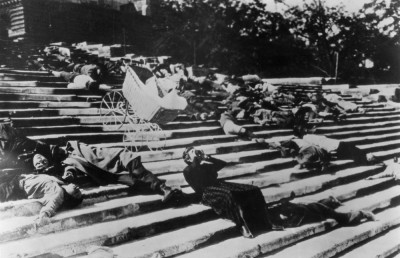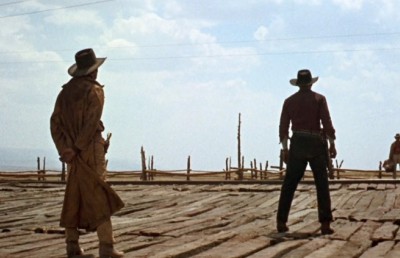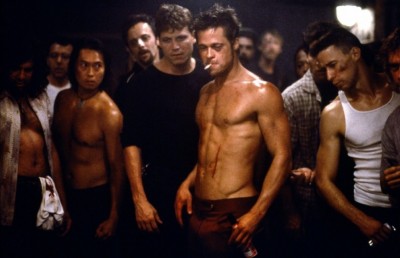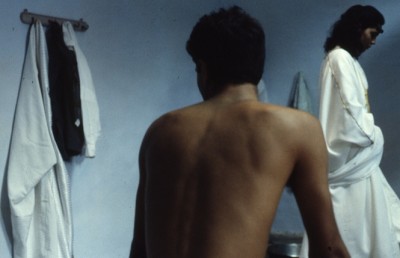Ang Lee’s Cowboys
Fallen from Brokeback’s Paradise Lost
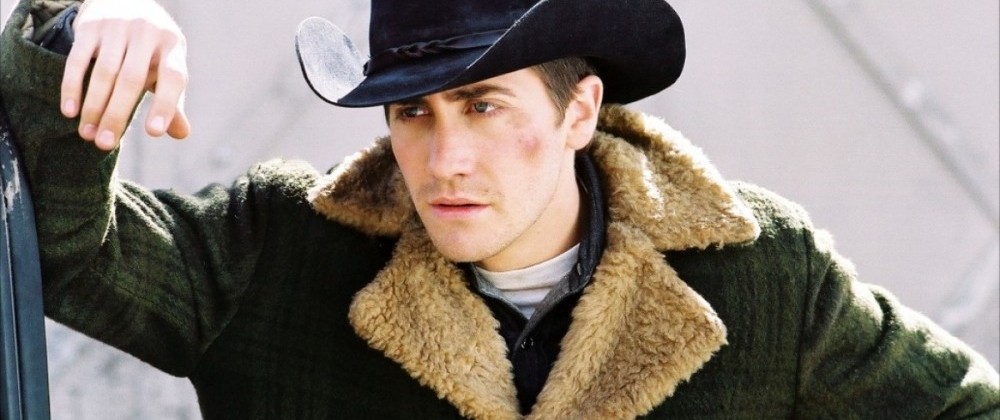
It seems to me we were all a bunch of romantic fools…
Henry Fonda in My Name is Nobody (1973)
Two cowboys, aged around 20, get a job in the summer of 1963, tending a large flock of sheep on the remote Brokeback Mountain in Wyoming. After some days have passed, their relationship turns physical. They leave Brokeback, they both get married, and, four years later, renew their loving relationship and continue to meet, now and then, on fishing trips into the wilderness, in a hopeless effort to rediscover their days of innocence on the mountainside.
Ang Lee’s Brokeback Mountain could be viewed as a film about homosexuality, which plays with the conventions and limits of the Western genre. It’s also a story of “an archetypal relationship which haunts the American psyche” [1] and a tale of loss and unfulfilled dreams. The argument I will set forth here is that director Ang Lee, in reversing the Western hero’s surface sexual characteristics (the cowboys usual macho masculine appearance is here being appropriated by gay sexuality –taking into account the inherent homosexual implications of the traditional Western hero), offers up a pure archetype of the romantic figure which can be found at the core of the Western mythology.
It is commonplace in film theory that the origins of the Western hero be traced to the speculative Romantic world. Starting from André Bazin, various critics have underlined the Western’s relation to the medieval romance. [2] As Kathreen Esselman points out, “the image of the knight and the concept of the quest are reflected in the American Western” [3] as a (distant) echo of the romantic turn of the ninenteenth century which brought about an awakening of interest in the Aurthurian romances that had maintained their popularity throughout the late Middle Ages.
The epic hero of the Western, torn between naturalness of the wilderness and the artifice of civilization, inhabits a timeless environment [4], defined by a landscape upon which the hero is fated to carry out his destiny. According to John Cawelti, the “formula” or standard plot structure of a Western is centered on an “epic moment” of confrontation between the pioneer and the wilderness. [5] “A transformation into an epic is evident in the set-ups of the shots, with their predilection for vast horizons,[…] which refuse to be limited by the frameline and restore to space its fullness.” [6]
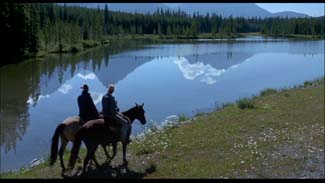
“In the American tradition, to move West is to free yourself of the cultural bonds to England […] to discover possibilities away from stale European culture, if at the price of the fear that comes from being lost in apparently limitless space.” [7] Thus, the West becomes diachronically “the one place open to freedom from civilization […] a place for gothic nightmares and for acting out unconscious fears, […] as a place merely abstractly symbolic of God’s ways.” [8]
Apart from the fact that the Western, as its name suggests, is defined, in large part, in terms of its setting, the genre’s romantic origins are suggested by its timelessness. In the epic world of the Western, “the life-immanence of meaning is so strong that it abolishes time: [9] life enters eternity as life, the organic retains nothing of time except the phase of blossoming,” [10] when, what the romantic hero experiences and the way he experiences it “has the blissful time-removed quality of the world of gods.” [11] In such a non-chronological temporal condition, “nostalgia has a collective utopian dimension […]; its yearning for a different time and progress – is disguised as a yearning for a different place,” [12] whereas the hero in space, whose relation to the past is itself religious, “seems to take his start outside time, or at the very outer edges of it, so that his location is essentially in space alone… the area of total possibility.” [13]
The history of the evolution of the Western moves from the representation of Rousseau’s “noble savage” (John Ford), who incorporates the dialectic subject-object (soul-form) union of the epic world –the continuity of the man-environment relationship and the reconnection with the lost center of the world’s soul– fulfilled in the emblematic power of the hero [14], towards the “novelistic” qualities of Anthony Mann’s films (those of the “romanticism of disillusionment” [15]), which dramatize Georg Lukacs’ allusion of the romantic hero’s justification into failure or defeat. [16] As Philip French points out: “Perhaps the most marked characteristic of the genre since the early Fifties has been its increasing emphasis not upon victory and success but upon losing –the suggestion that to remain true to oneself will almost invariably result in defeat.” [17] The “mature sense of limitation and unavoidable guilt [as paying the constant price of the fall] is what gives the Westerner a ‘right’ to his melancholy.” [18]
Several film theorists and critics have discerned the religious nature of the Western hero as a coming together of certain elements from the Old and New Testaments. [19] The Western hero, thus, retains traits of the grimmest Puritanism and embodies a reclusive interiority that was only an ideal even for seventeenth-century Puritans, incorporating the puritan biographical method which was “to fuse faith together with an individual life, the geography of the land, and American history.” [20] This kind of Christianism is the instrument of an eternal torture of the soul, leaving the exile, the loneliness, the grief and the guilt, as a valuable consignment of the inner (wo) man. Thus, “the Christianity of the American imagination, of the American Desert, is an individualistic one,” [21] revealed in the Western’s impulse toward the loving God but “revolted” by men who derive “pence and power” by claiming to represent Him on earth. [22]
The epic hero of the Western reveals, therefore, the various cosmic forms of the Bible’s literary cryptology in the romantic reading of medieval occult. The resurgence of the gothic tradition, the nostalgia of the mystical Middle Ages and its hidden visionary allegories, along with the constant wandering in the dark land of heretic Christianism, have been the main ingredients of the romantic language.
Brokeback Mountain could be viewed as a contemporary allegory of the type, by making use of all the conventions and romantic implications of the Western genre, since “the Western always looks backward from the vantage point of a ‘fallen’ culture to a Garden of Eden from which it has been expelled.” [23]
The film, with its location-defining title typical of the traditional Western’s monumentality, is characterized by a significant disproportion in narrative pace. The first part, describing the days on Brokeback Mountain has a languid pace, capturing the volume of time as it slowly slips away, thus being perceptively closer to human temporal experience than the section narrating the boys’ family routine, which spans a time period of nearly twenty years by presenting only the highlights of events. The “realistic” (meaning naturalistic) effect of the first part’s temporal structure corresponds to the boys’ sense of living their “true” life, which is in opposition to the second part’s falsifying time-constructing decoupage. Furthermore, the film suggests a timelessness by keeping the physical appearance of the boys fairly consistent. Ennis (Heath Ledger) and Jack (Jake Gyllenhaal) are theoretically growing older, and gain a little weight perhaps or grow a moustache, but the child-like expression on their faces, their tone of voice and mocking “manly” behaviour remain, as always, revealed through familiar gestures and looks. We can gather by the plot’s development the passage of time, but we are unable of feeling it as do the characters. Time passes around the edges of characters, leaving the two boys in a deep engagement of time-revolving repetition, actual or illusionary, of their blissful days of beatitude on Brokeback. One of the film’s most moving scenes is indicative of this subjective-made objective merger of past, present and future (although we assume it is the visualization of Jack’s memory –subjective– it is presented as a flashback focalized by the director’s point of view –objective). At the end of their last coming together, and after Ennis’ first actual outburst and Jack’s expression of indignation, we watch Ennis get into his truck and disappear. At this very moment, and without any cinematic indication of an objective flashback, representation of a subjective illusion, or memory, we now watch Jack, at the age he had been during the days on Brokeback, standing by the fire ashes, tired and ready for sleep. After Ennis’ tender hug from behind, we find Ennis, also at the younger age of the Brokeback days, riding away, while Jack, with the same old look, only with a sweeter expression, listening to him say that they are going to see each other in the morning. The structure of the scene is almost identical to the one after the boys’ night together when Jack is heard saying to Ennis “see you for supper,” while watching him ride away. This leaves the impression of the 20 years being summed up in just one night’s (one nightmare’s?) subjective time passage. This seed of past time being thrown into the current course of the scene fertilizes the present state of loss with the promise of a never-ending comeback.
Ang Lee’s cowboy epic characterization can be seen as emerging through the two characters’ romantic encounter with the Demonic Sublime in Brokeback’s Paradise Lost. In a way similar to Milton’s intentions in his poem, the Demonic “is pride and sensual indulgence, finding in self the sole motive of action,” [24] whereas the intimate revelation of the poem, as Coleridge suggests, is to be found in his heartfelt descriptions of the connubial felicities in the Garden of Eden. [25] Furthermore, the film dramatizes James Fenimore Cooper’s [26] dream of manhood, fictionally implied in all his Western novels, by symbolically outlining “a stark, stripped human relationship of two men, deeper than the deeps of sex. Deeper than property, deeper than fatherhood, deeper than marriage, deeper than love. So deep that it is loveless. The stark, loveless, wordless [Ennis’ silence] unison of two men who have come to the bottom of themselves.” [27]
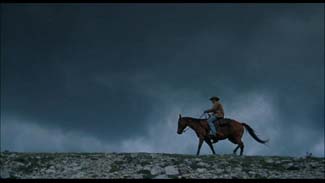
There resides the Sublime, which, for the romantic language hints a spiritual truth, living its rupture between the two more crucial poles of ethical sphere: innocence and sin. The Sublime symbolizes the recognition of inner man’s destiny in fear and nightmare, in his agony to cross the routes of the world, fighting the illusion of the harmony of a divinable universe. In the Sublime image of the fallen world, evil exists as an inherent form of Creation’s human providence, participating, thus, in the divine perspective inasmuch as God’s will.
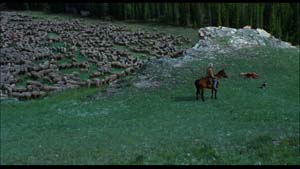
The film’s first religious symbolism comes on the morning after the boys have had sexual intercourse, with Ennis’ discovery of a dead sheep which has died as a result of his neglect. As punishment for his ‘sin,’ divine intervention is symbolically represented throughout the film by a God-like figure, their employer, significatively named Aguirre [the wrath of God?]. An indication of the film’s metaphysical speculation can also be found in the metaphor of Ennis wife’s name: Alma (soul). Alma is the only true witness of her husband’s love affair with his ‘fishing friend,’ while standing for the “cause” of his social failure and misery. The latter is an important element of Jack’s personal malaise. Alma’s divorce leaves Ennis with too many family responsibilities –spending time with his daughters on weekends, being obliged to pay child support– to find time to share with Jack (he continually misses their monthly visits). In addition, Ennis and Jack’s family background is revealed as being characterized by the religious faith of their parents, who were both followers of two of the most austere denominations of Protestant Christianity: the Methodist and Pentecostal movements.
After Aguire’s chance discovery of the two boys’ sensual play across the fields, he informs them of their expulsion from Brokeback. As in Paradise Lost, in which “the interest arises from the daring ambition and fierce passions of Satan, and from the account of the paradisaical happiness, and the loss of it by our first parents” [28], the exile here gets a particularly agonized character, which leads to the primordial origin of the “original sin,” to the mythologized form of the human fall from the heavenly perspective of eternity. Furthermore, by portraying the two boys as shepherds in Brokeback’s Garden of Eden landscape, the film refers to the structural pattern of the pastoral which was to “reestablish a harmony […] if arriving at it through a deeper melancholy, as in Virgil’s first Eclogue, which ends with the shepherd who has been exiled from his lands.” [29]

The two boys are excluded from Brokeback’s Garden of Eden and never do return. Their life of “exile” within their family, independently of social class or economic status (as indicated by the cross-cutting between the two families’ Thanksgiving table), or social and professional routine (with compositions centered around the eyes [30], which brings to mind Sergio Leone’s close-ups) is described as their own tortured nightmare. Their attempts to regain the mythical, quasi-utopian past of bliss and innocence through their sporadic visits to remote fishing locales becomes the price of their loss and guilt. Their ‘Fall’ is not only a symbolic expression of human fate, but an all-embracing destiny of humanity and nature, joined through their painful secret.
Jack’s death at the end of the film remains the sole reliable ending for the romantic tragedy of human fate: death as expiation from a world mired in guilt, a disease which drags man to transcendental redemption.
Brokeback Mountain outlines its characters as exiles from a Christian-bourgeois society. By situating them in a Demonic wasteland, constantly trying to re-enact death and resurrection and the return to a paradisiac garden, [31] Brokeback Mountain provides us with an archetypal hero(es), but situated in a Western mythology viewed from a post-romantic perspective which still clings to a nostalgic vision of the world as a ‘paradise lost.’
Endnotes
1 Leslie Fiedler, Love and Death in the American Novel, New York: Stein and Day, 1966 (revised).
2 A. Bazin, “The Western: Or the American film par excellence”, in What is Cinema Vol. II, trans. Hugh Gray, Berkeley: University of California Press.
3 Kathryn C. Esselman, “From Camelot to Monument Valley: Dramatic origins of the Western film” in Focus on the Western, edited by Jack Nachbar, New Jersey: Prentice Hall, 1974, p. 9.
4 Stanley J. Solomon, Beyond Formula: American Film Genres, Harcourt Brace, 1976, p. 27. About the timelessness of the epic see: Georg Lukács, “The romanticism of disillusionment” in The Theory of the Novel, trans. Anna Bostock, Cambridge: The MIT Press, 1971.
5 John G. Cawelti, The Six-Gun Mystique, Ohio: Bowling Green University Popular Press, 1971.
6 A. Bazin, “The Western: Or the American film par excellence” in What is Cinema? Vol. II, p. 147.
7 S. Simmon, The Invention of the Western Film, Cambridge: Cambridge University Press, 2003, p. 95.
8 Ibid., pp. 14-15.
9 As Jack Nachbar puts it: “The passage of time has done the most obvious damage to the traditional western” (“Riding shotgun: the scattered formula in contemporary Western movies” in Focus on the Western, p. 109).
10 G. Lukács, The Theory of the Novel, p. 122.
11 Ibid.
12 S. Simmon, The Invention of the Western Film, p. 182.
13 Ibid., p. 188.
14 Jim Kitses, “The Western: Ideology and archetype,” in Focus on the Western, p. 71.
15 In the Theory of the Novel.
16 See Georg Lukács, “The Foundering of Form Against Life,” in Soul and Form, trans. Anna Bostock, London: Merlin Press, 1974.
17 Philip French, Westerns: Aspects of a Movie Genre, London: Secker & Warburg, 1973, p. 52.
18 R. Warshow, “The Westerner,” in Film: An Anthology, edited by Daniel Talbot, Belkeley: University of California Press, 1975, p. 154.
19 See for instance: Michael T. Marsden, “Savior in the saddle: The sagebrush testament” in Focus on the Western.
20 S. Simmons, The Invention of the Western Film, p. 126.
21 M. T. Marsden, “Savior in the Saddle: The Sagebrush Testament” in Focus on the Western, p. 98.
22 S. Simmon, The Invention of the Western Film, p. 129.
23 John Belton, American Cinema, American Culture, N.Y.: McGraw Hill, 1994, p. 223.
24 M. H. Abrams, “Milton, Satan and Eve,” in The Mirror and the Lamp, London: Oxford University Press, 1953 (reprint 1980), p. 253.
25 See: ‘An apology for poetry” in Elizabethan Critical Essays.
26 Novelist J. F. Cooper may well be considered as the key originator of the genre.
27 S. Simmon, The Invention of the Western Film, p. 23, from D. H. Lawrence, Studies in Classic American Literature, Harmondsworth, U.K.: Penguin Books, 1924, pp. 59-60.
28 M. H. Abrams, The Mirror and the Lamp, p. 254.
29 S. Simmon, The Invention of the Western Film, p. 21.
30 In the romantic mythology the eye is a symbol of the creative imagination of the individual, especially in his subject-object dialectic gaze on the world.
31 Jim Kitses, “The western: Ideology and archetype” in Focus on the Western, p. 69.


